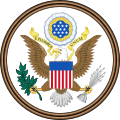List of Democratic-Republican tickets
1792
| Presidential nominee | 1792 (lost) [a] | Vice presidential nominee | |
|---|---|---|---|
| None |
| George Clinton of NY (1739–1812)  | |
| Opponent(s) George Washington (Independent) |
| Opponent(s) John Adams (Independent) | |
1796, 1800, 1804
| Presidential nominee | 1796 (lost), 1800 (won), 1804 (won) | Vice presidential nominee | |
|---|---|---|---|
| Thomas Jefferson of VA (1743–1826)  |
|
| Aaron Burr of NY (1756–1836)  (1796, 1800) |
| George Clinton of NY (1739–1812)  (1804) | ||
| Opponent(s) John Adams (Federalist) |
| Opponent(s) Thomas Pinckney (Federalist) | |
| Opponent(s) Charles Pinckney (Federalist) | ||
| Opponent(s) Charles Pinckney (Federalist) |
| Opponent(s) Rufus King (Federalist) | |
1808, 1812
| Presidential nominee | 1808 (won), 1812 (won) | Vice presidential nominee | |
|---|---|---|---|
| James Madison of VA (1751–1836)  |
|
| George Clinton of NY (1739–1812)  (1808) |
| Elbridge Gerry of MA (1744–1814)  (1812) | ||
| Opponent(s) Charles Pinckney (Federalist) |
| Opponent(s) Rufus King (Federalist) | |
| Opponent(s) DeWitt Clinton (Federalist) |
| Opponent(s) Jared Ingersoll (Federalist) | |
1816, 1820
| Presidential nominee | 1816 (won), 1820 (won) | Vice presidential nominee | |
|---|---|---|---|
| James Monroe of VA (1758–1831)  |
|
| Daniel Tompkins of NY (1774–1825)  |
| Opponent(s) Rufus King (Federalist) |
| Opponent(s) John Howard (Federalist) | |
| Opponent(s) None |
| Opponent(s) Richard Stockton (Federalist) | |
1824
| Presidential nominee | 1824 (won) [c] | Vice presidential nominee | |
|---|---|---|---|
| John Quincy Adams of MA (1767–1848)  |
|
| John C. Calhoun of SC (1782–1850)  |
| Andrew Jackson of TN (1767–1845)  |
| ||
| William Crawford of GA (1772–1834)  |
|
| Albert Gallatin of PA (1761–1849) [d]  |
| Nathaniel Macon of NC (1757–1837)  | ||
| Henry Clay of KY (1777–1852)  |
|
| Nathan Sanford of NY (1777–1838)  |
| Opponent(s) None |
| Opponent(s) None | |
